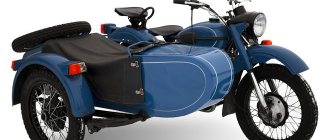The booming sound of engines, crushed ice, the strong smell of methanol in the air, adrenaline taking over the body - this is ice speedway, one of the most spectacular and impressive types of motorsport. At the same time, speedway is one of the most difficult and risky disciplines. The athletes here are called gladiators. These racers are true brave men, real men, desperate guys with no brakes. There really are no brakes on their motorcycles.
Each new ride greatly destroys the ice cover, and the road becomes more and more risky. Maintaining control of the vehicle and not flying into the track fence is very difficult - concentration is extremely important on ice. The penalty for any mistake is a fall and serious injury. As in all mechanized sports, complete self-organization and technical preparedness are required here. In addition, you need to have a huge desire for the championship. The vast majority are not good at this sport, and they quit the race without achieving their goals. The ability to restrain yourself and accept failures is important here, because not everything always goes smoothly.
Speedway: what kind of sport is it?
Ice speedway is motorcycle racing on an ice-covered track. The length of the oval ice track is 260-425 m. The motorcycle speed on turns reaches 80 km/h, and in a straight line – 200 km/h.
The difference between an ice racing motorcycle and a regular cinder motorcycle is the presence of metal spikes on the treads. One of the most exciting things about ice speedway is the turns around the corners. It seems that no physical laws apply here, because motorcycle racers almost lie on their sides during races. The engine power is about 500 cm³. Such a vehicle does not even have a starter.
The number of riders in one race is 4-6 people. According to the regulations of the ice speedway, one race consists of four laps, which in total amounts to a little less than two kilometers. Those motorcycle racers are lucky to be the first to participate. They race on a flat, compacted road, but after just a few races the track becomes like plowed arable land. On an icy track, the athlete has no right to make a mistake, since the slightest error threatens the loss of the leading position, which there will simply be no time to regain due to the transience of the race.
All turns take place in drifts, which, in the absence of brakes, allow riders to reduce speed. One of the reasons why ice speedway is considered a spectacular discipline is because of the frequent falls. Having lost control, athletes fly straight into the fence and often suffer serious injuries.
The thickness of regular ice at the skating rink reaches about ten centimeters, which is acceptable for skates, but for speedway races an additional 30 cm of coating is added. All this is necessary, because the sharp “claws” of the tires cut serious grooves about five centimeters deep in it after the race.
Points for the competition are awarded based on the results of the final races, which complete each day of races. The winner is determined based on the total number of points for the season. Such rules are the result of many years of development of motorcycle racing on ice, which today is called ice speedway.
Motorcycle racers of the Soviet Union, and then the Russian Federation, have had no equal on the ice track for many years, leaving behind even the obvious pioneers of these races - the Finns and Swedes.
Championships and their winners
If we look at the standings of competitions in various years, we can proudly note that ice speedway is almost a traditional Russian sport. See for yourself:
- World Cup 2000-2015: our country was the winner 15 times and Sweden only 1 time. The following athletes distinguished themselves: Daniil Ivanov, Dmitry Koltakov, Nikolai Krasnikov, Vitaly Khomitsevich, Kirill Drogalin, Dmitry Bulankin.
- European Championship 2000-2015: again 15 victories for Russia and 1 victory for Austria. The following domestic motorcycle racers celebrated the triumph: Maxim Zakharov, Yuri Polikarpov, Dmitry Bulankin, Vladimir Fadeev, Dmitry Khomitsevich, Andrey Shishegov, Igor Saidullin, Yunir Bazeev, Vasily Kosov, Vasily Nesytykh, Sergey Karachintsev.
Racing Rules
Competitions are organized in accordance with the rules of the sport “Motorcycling”, the rules of the International Motorcycle Organization (FIM), technical requirements for FIM and IFR motorcycles, the FIM Medical Code, as well as regulations and regulations.
In general, the rules are similar to regular motorcycle racing. One race involves four riders, either as a team or individually, making four laps around the track. The length of the distance can be different - up to 1700 m (425 m x 4 laps). The one who reaches the finish line first wins. Second and third places are awarded accordingly.
Persons who have undergone the necessary theoretical and practical training, a medical examination, have a doctor’s certificate, as well as insurance in accordance with the legislation of the Russian Federation are allowed to participate in the competition. To be allowed to compete, a motorcycle must be inspected by a technical commissioner. They also inspect the protective helmet, suit and all protective equipment.
In total, 18 people enter the competition (16 main and two reserve). 4 people take part in each race of the competition. At Russian competitions there are 5 series of races. Athletes meet each other (each athlete meets all opponents in a competition) according to the compiled table. Those who score the most points become race winners. At the stages of the World Championship, the first 8 people who scored the most points in five races are distributed to two semi-finals. The winner of each semi-final goes to the final, where it becomes clear who will be the strongest.
A racing track is similar to a cinder track; often competitions are organized on the same tracks, only filled with ice. Sometimes competitions are organized on icy lakes. Athletes ride along the track counterclockwise. The track size can reach 425 meters. The start line (which is also the finish line) is drawn along the entire length of the start area at a distance of 35 meters from the beginning of the first bend. The launch area is equipped with a special launch machine, consisting of two vertical posts and a lifting mechanism controlled by a remote control. A motorcycle racer who falls or breaks the rules, for example, crosses the blue line that defines the internal boundaries of the track, leaves the race.
The bike is launched immediately, approximately from two pushers. Due to them, the bike accelerates. Taking his seat, the motorcycle racer presses the clutch lever. When the engine is running, you need to open the throttle. In the intervals between races, the bike is covered with a warm cape.
During the start, the rider must position the body correctly - both legs are firmly planted on the ground, the body is slightly leaned forward to prevent strong lifting of the front wheel. The athlete opens the throttle handle 6 meters from the start and does not close it until the next turn. When making a turn, the rider must avoid abruptly closing and opening the handle to prevent loss of control of the bike.
Driving a motorcycle on straight sections is no different from cinder racing. They differ from each other by turns. At the moment of a turn in an ice speedway, a motorcycle racer must ride at maximum speed and observe the location of competitors. In this case, the athlete leans heavily over the ice, and good grip on the road is provided by studded tires. Rubber knee pads help prevent impacts on the ice. Correct leaning of the motorcycle and body is very important when making a turn. The tilt should be in the direction of the turn to maintain balance. The same angle of inclination of the body and the motorcycle is the most common method. When the athlete follows in a straight line, he assumes a normal driving position. At this time, you have the opportunity to relax your muscles a little and prepare for the next turn.
For motorcycle racing, regular stadiums are filled with ice. In the Russian Federation it is easier to do this, so athletes skate on natural ice. Abroad, people skate on artificial ice, that is, where speed skaters practice. The ice season usually begins in November - training camps and training. The first competitions are already organized at the beginning of December. Almost every weekend, a motorcycle racer will have to travel to competitions from city to city or to different countries, until April. During the “ice-free” season, gladiators maintain their physical fitness by taking part in motocross or driving on dirt tracks. Today, the geography of speedway is quite wide, which is why not only world and European championships, but also individual countries, are played on an annual basis. The most prestigious team championships are held in Poland, Great Britain, Denmark, Sweden and Russia. Among the countries where ice speedway is developed, Russia is considered the strongest.
NOT FINISHING THE SERMON.
Cinder track racing, or simply speedway, appeared at the beginning of the twentieth century, and almost all countries became afflicted with it amazingly quickly.
The year of birth of the species is considered to be 1923, when the Australian John Hoskins, who had a government-issued motorcycle at his disposal, decided to have a blast in the company of friends. There was no better place for racing than the local racetrack. Everything would have gone unnoticed if it weren’t for Sunday and the nearby church. The roar of engines drowned out the sounds of the church organ, and the parishioners, having forgotten about the service, rushed towards the sound. These were the first spectators of a new type of motorsport. Hoskins himself was at first frightened by the sold-out crowd, but he got the hang of it, and thanks to his efforts, within a couple of weeks “races at the hippodrome” were being talked about throughout the area. Motorcyclist races became regular, and enthusiasts began to develop speedway rules. Gradually, the geography of the competition expanded, and soon it became crowded on the Australian continent. Europe was next in line.
In the Northern Hemisphere, the first race took place in 1928 on the islands of Foggy Albion, and already in 1929 the first team league appeared in England. Soon teams and championships began to be organized across the continent.
Currently, cinder track racing is most popular in Poland, England, Sweden, Denmark, the Czech Republic and Russia. Among the top class racers there are both Americans and Australians. However, their main place of work is Europe: today the Old World is the center of the world speedway. There are many leagues and championships in which athletes from all over the world and at different levels have the right to compete.
Motorcycle Features
Initially, vehicles for motorcycle ice racing were almost homemade. The racers welded frames onto which studded tires were mounted, as well as guards that covered the wheels as a safety system.
Later, ice speedway enthusiast, famous racer and coach Vladimir Karneev created a frame with significant modifications, thanks to which the bike gained increased stability on ice. The innovation introduced by V. Karneev was so significant that to this day, the main supplier of motorcycles for ice speedway, produces V. Karneev’s frame without any special changes.
The bike for competitions is maintained by all team members, but any modifications to the design in order to increase the resources of the motorcycle are not allowed. If the weight of the bike exceeds 110 kg, this can significantly affect acceleration, speed and cornering factors.
The bike has only two speeds, with the first one only needed at the start. There are no brakes at all. The motor runs on methanol. It is necessary to install smaller jets and stars, which makes the engine easier to operate. The tank of such a bike holds 3.5 liters of fuel, which is enough to cover four kilometers.
Bikes participating in international competitions have an engine capacity of 500 cm³. Engines of 125, 250, 350 and 450 cm³ are also used in competitions. Historically, ice racing bikes used Czech engines, which are still dominant today.
The predominant features of ice speedway bikes are a stiffer frame and a longer wheelbase. The studs on the treads look very menacing, as they dig into the icy track and hold the athlete when entering a turn. Unlike conventional racing ones, speedway bikes do not have aerodynamic fairings; a necessary condition is the presence of a front wing and a rear hood over most of the wheel.
These parts are made of durable plastic and reliably protect against studded wheels. Typically, the most studs are placed on the left side of the wheel, since the bike moves counterclockwise and turns on this side. Basically, a three-row stud is used - a turn, a starting and an auxiliary row. About 120 studs are installed on the front wheel and 180 on the rear. The length of the spike is 28 mm. They are made from particularly strong alloys and are equipped with a wide base for attachment to the tire. These spikes are truly formidable weapons. Moreover, any fall, and this happens in almost all races, can result in serious injuries and even death for the athlete.
EXTREME CAR
From a technical point of view, speedway is very different from other types of motorsports. What exactly? Racer of the Latvian Speedway Center club, European vice-champion among juniors Kestas Puojuks will help you figure it out:
— A speedway motorcycle is a composition of a minimum set of parts and assemblies that ensures that the rider gets from start to finish in the shortest possible time. The controls are only the clutch lever and the throttle. The engine is a single-cylinder, 4-valve, 500 cc, with a maximum speed of about 10,000–11,000 rpm, depending on the modification. Speedway engines are produced by two companies: the Czech Jawa and the Italian GM. There is only one gear, which simplifies the entire design. For training, especially at the initial stage, they use 125 cc cars, but for “adult” training and especially racing - only “five hundred”. Moreover, for high-level competitions, tuned engines are installed. For example, Finnish craftsmen were involved in fine-tuning mine. Using their proprietary secrets, they achieve some improvement in engine performance. In what case and what engine to use is decided by the athlete himself, depending on the situation: it all depends on the composition of competitors in the race, on its rating. If it is low, then no one will waste the potential of the tuned engine.
The sore spot of a speedway car is the chain. She experiences very high loads, so her condition needs to be constantly monitored. A new chain is never used in a race: a new one is a “dark horse”. And a chain break is a fairly common reason for a rider leaving the track. First, she is tested in training, carefully examined, and only after that she is “allowed” to take part in the race.
As for the suspension, the motorcycle has only one shock absorber - in the front fork. Its design is quite extraordinary compared to conventional bikes. It serves more for better handling of the motorcycle than for comfort. The rear wheel is rigidly fixed to the frame: since it skids most of the route, it does not need unnecessary vibrations.
In general, the rear wheel deserves a separate story. But in short, it almost always slips (and “from the heart”) both at the start and when cornering. Therefore, the tire has to be screwed to the rim with self-tapping screws so as not to tear it off. Due to such harsh conditions, the cylinder is only enough for two races. In the first, the left half of the tread is ground off - the tire is turned, the remaining “half” is enough for one more race. After the competition, the slick is either thrown away or kept for training.
Equipment
All safety standards must be observed at competitions, and high-quality equipment is one of them. Today it is not difficult to believe that a motorcycle racer, dressed in high-quality professional equipment, sometimes ends up with only minor bruises when falling from his bike at great speed.
Modern motorcycle racing suits are not easy to even put on, require assistance from others, and are almost impossible to wear in everyday life due to the discomfort and heat. But when the rider in such protection sits on the bike, everything falls into place - the body immediately finds an ideal and comfortable position, and the icy gusts of wind only refresh the body.
Such suits are made of genuine leather and equipped with special absorption zones, as well as stiffening ribs. Recently, another innovative solution was used - placing airbags under protective suits. But until recently, the rider was protected only by a plastic motorcycle helmet.
Protection for the back and chest area must be worn under the overalls. There are also special motorcycle boots, and the left boot is equipped with carbon protection, in which the leg must bend, since the leg serves as a third point of support. In addition, it can be used to control a motorcycle. An outer knee pad is placed on top of the inner knee pad. Thanks to him, the foot glides on the ice and is not damaged. Additional protection is also provided by elbow pads, a balaclava, a torso vest and motorcycle gloves. The helmet and goggles are changed after each lap.
What is the most significant competition in ice speedway?
The FIM Ice Speedway Gladiators (Individual World Championship in motorcycle ice racing) is a competition of the world's outstanding athletes, held annually since 1966.
The tournament is divided into five finals, held on tracks in different cities. Each final consists of two stages, running as separate races. In general, the format of the World Championship is as follows : five series of 4 races are held on the principle of “each with each”. The highest number of points scored determines the eight athletes who subsequently qualify for the two semi-finals.
The winner of each semi-final advances to the championship final. The winner is determined based on the results of the final race. Points based on the results of the “play-off” races are added to the points scored in the main part. The athlete who receives the most points from all finals becomes the world champion.
From 1966 to 1993 The championship included qualifying tournaments and the final, which was held over one or two days. At first, the championship used a points system in the finals (the first six places qualified, for which 1 to 8 points were awarded), and from 1967 to 1993. Only the points scored in the races were taken into account.
In 1994, the Grand Prix system was introduced, that is, the structure of the qualifying stages was preserved, but changes were made to the final segment: one final was organized in selected cities and each final was held over two days. The place taken by the athlete on each day determined the number of his test points. The points totaled at the end of the season determined the winner.
Since 2012, the principles of the Grand Prix have been preserved, but only heat points were taken into account, as well as a system of two semi-finals for the top eight riders and the final, identical to the cinder Grand Prix. The only difference is that the points received in the final were not doubled.
How dangerous is speedway racing?
Speedway is a truly masculine sporting discipline. Injuries are inevitable here - this is a truly dangerous sport. The driver may lose control as a result of a collision with an opponent or as a result of entering a corner too sharply and at the wrong speed. This way the athlete can easily fly into the fence. The many spikes on the treads pose a very big risk; contact with them in a fall can result in serious consequences.
In addition, after several races, the track becomes even more dangerous for the riders, as it is heavily damaged by numerous spikes. Of course, high-quality equipment protects athletes from falls, but does not provide insurance against serious injuries in general, such as fractures, severe bruises or lacerations. However, safety in motorsports does not stand still, and since relatively recently the use of inflatable sides and bump stops has become mandatory .
Where are the strongest motorcycle racers?
Representatives of the Russian Federation are undeniably leaders in this discipline. In Russia, motorsports receive government support. In the budgets of many regions there are provisions for assistance to relevant clubs and schools. In the Sverdlovsk region and Togliatti there are special schools for children and youth where very young motorcycle racers train. From the age of five they ride special small bikes. Here they gain initial skills, then choose one of the types of motorsports they like.
Many clubs are budget organizations. The club provides the rider with a motorcycle, a mechanic and wages, and pays for business trips to competitions. In addition, spare parts and everything necessary are purchased with the allocated funds.
There are no training sessions as such. Training camps begin at the end of November, when ten days of pre-season training take place. Then the competitions begin, which are usually organized on weekends, and between races the athletes move to different cities.
There are no clubs abroad, and athletes train on their own. They purchase spare parts themselves and assemble motorbikes in their garages. This is the reason that not many people are involved in motorsports abroad, which is why the competition is lower.
The Russian Championship is definitely the strongest motorcycle racing in the world. Getting into the top five at the Russian Championship is harder than being in the top five at the World Championship. And if in Europe races are organized once a year, then in the Russian Federation they are organized constantly. In addition, winter cold comes here earlier, and racers from different countries come here for training camps, to participate in competitions and, of course, to borrow the experience of Russian pilots.
A little history
The very first motorcycle races, or more precisely, races involving motorcyclists, were long-distance races that took place along public roads connecting large cities. Their main goal was to prove that the motorcycle, which had only recently seen the light of day, was a completely promising vehicle. However, this method of attracting public attention was quite poor: it was simply impossible to follow the race. All the viewer could do was watch the participants pass by for a few seconds and later read the results published in one of the newspapers.
However, the public still managed to interest the new two-wheeled vehicle and its impressive (for those times) speed. The real breakthrough in popularity was suddenly associated not with an increase, but, on the contrary, with a decrease in the scale of racing that occurred in the 1920s. In addition to the rapidly growing motocross competitions, they began to be held at regular racing stadiums or racetracks - hence the relatively short lap lengths.
Such a decision had a fairly impressive list of advantages for absolutely everyone involved in the competition: from organizers and racers to spectators:
- the tracks practically did not require additional equipment, which means that organizing a race was relatively simple,
- the simple shape and flat surface of the track allowed us to confidently increase the power of motorcycles, making participation more interesting and exciting,
- the track was perfectly visible from the stands, so spectators could easily watch the struggle of the racers throughout the race,
- The races were spectacular, but short enough to not get boring.
As a result, all this resulted in the emergence of the so-called classic speedway and the holding in 1936 of the first World Championship, held in London under the auspices of the International Federation of Motorcycle Clubs (FICM). Subsequently, it began to be held annually.
As for the history of speedway in the Soviet Union, despite our country lagging behind Europe in terms of technical development, speedway was very popular. The first Russian Championship was held at one of the Moscow hippodromes already in 1920. Subsequently, the competitions were moved to football stadiums, and the Championship was renamed the Soviet Union Cup. It was held until the Second World War, which interrupted the development of motorcycle sports not only in our country, but throughout the world.
However, this does not mean at all that by that time the speedway had finally taken shape and remained unchanged to this day. On the contrary, the direction and the technique used in it continued to develop, which led to the emergence of new types of competitions.










